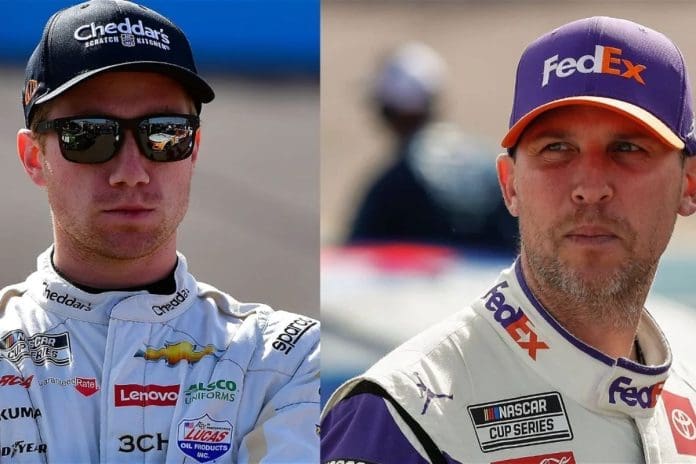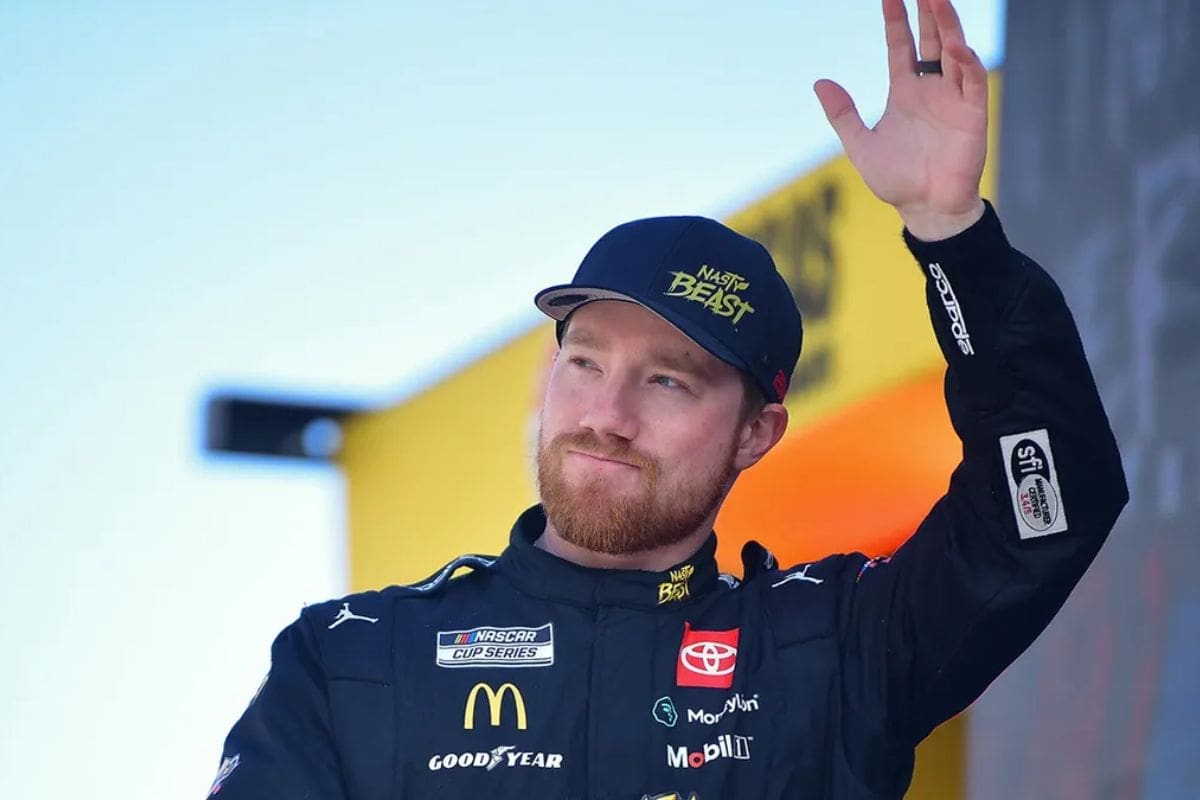Tyler Reddick’s Chicago Blunder: Denny Hamlin‘s recent analysis of Tyler Reddick‘s attempt to overtake Alex Bowman during the Chicago Street Course offers a compelling examination of tactical driving within NASCAR. Hamlin emphasized the critical elements of positioning, patience, and composure, critiquing Reddick’s missed opportunities and advocating for a more calculated approach to overtaking. This critique not only highlights the intricate dynamics of race strategy but also serves as a guide for Reddick’s future performances. What specific insights did Hamlin provide, and how might they influence Reddick’s approach in upcoming races?
Key Highlights
- Denny Hamlin critiqued Reddick’s aggressive overtaking attempt on Alex Bowman in Chicago, emphasizing cautious driving.
- Hamlin highlighted Reddick’s misjudgment in tire strategy, impacting his ability to secure a clean pass.
- Reddick’s lack of patience under pressure was pointed out by Hamlin as a critical error in the Chicago Street Race.
- Hamlin stressed the importance of strategic positioning and maintaining composure during overtaking opportunities.
- Reddick’s need to refine his passing tactics to convert opportunities into victories was a key focus of Hamlin’s analysis.
Tyler Reddick’s Recent Performance Challenges
Tyler Reddick has consistently displayed strong performance on the track, yet his recent races in Nashville and the Chicago Street Race highlight the challenges he faces in converting opportunities into victories. Despite his evident talent and competitive edge, Reddick’s struggle to clinch victories emphasizes a series of intricate challenges that merit closer examination.
Analyzing Reddick’s performance, it is clear that his driving skills and strategic insight position him as a formidable competitor. In Nashville, his ability to maintain a strong pace and navigate through traffic showcased his racing expertise. Likewise, during the Chicago Street Race, Reddick demonstrated his adaptability on a circuit that demands precision and quick decision-making. However, these strong performances did not translate into wins, pointing to underlying issues that need addressing.
One significant factor is the timing and execution of race strategies. Reddick’s near-misses suggest that while he excels in maintaining competitive speed and positioning, there may be gaps in strategic decisions, particularly in the closing stages of the race. Whether it involves tire management, pit stop timing, or in-race adjustments, these elements are essential for converting a strong performance into a win.
Furthermore, external variables such as track conditions, competitor actions, and unforeseen incidents also play a noteworthy role. Reddick’s ability to respond to these variables with agility and foresight is critical. However, recent races indicate that despite his skill, these external factors have occasionally disrupted his race flow, preventing him from securing the top spot.
Nashville Superspeedway Incident
The Nashville Superspeedway incident captures the intricate dynamics of race strategy and execution, where despite a bold push through a chaotic quintuple overtime, Reddick fell just short of overtaking Joey Logano in the final moments. This race provided a master class in strategic positioning and endurance, particularly in the late stages of the competition where split-second decisions can be the difference between victory and defeat.
Tyler Reddick’s approach was marked by calculated aggression, skillfully moving through a congested field and utilizing every opportunity to advance his position. As he closed in on Logano, Reddick displayed remarkable car control and tactical savvy, especially in the high-pressure scenarios that defined the overtime laps. His ability to reach Logano’s bumper in turn 3 of the final lap was a testament to his skill and resolve. However, executing a pass in such conditions requires not only precision but also a degree of risk that can either result in a successful overtake or a costly miscalculation.
For Reddick, the inability to complete the pass emphasizes a key lesson in balancing aggression with patience, a fine line that often dictates the outcomes in high-stakes racing scenarios.
Chicago Street Race
Following the intense showdown at Nashville Superspeedway, Reddick faced a fresh set of challenges in the Chicago Street Race, where tire strategy played a significant role in the unfolding drama.
The Chicago circuit, demanding in its complexity, saw Reddick competing under less-than-ideal conditions due to his decision to stick with slick tires. This choice contrasted sharply with Alex Bowman’s wet weather tires, which provided superior grip on the damp street surface.
Despite the apparent disadvantage, Reddick displayed impressive driving skill and resolve. He managed to close the gap on Bowman, maintaining competitive lap times and exhibiting tactical expertise. As the race progressed, Reddick’s ability to navigate the slick conditions with such finesse became a focal point, highlighting his adaptability and tenacity.
The critical moment arrived on the final lap, where Reddick was poised to execute a crucial overtake on Bowman. His strategy, hinged on precision and timing, saw him drawing nearer to Bowman’s rear. However, as they approached turn 5, a crucial misjudgment by Reddick led to him hitting the inside wall. This error proved costly, causing a noteworthy loss of momentum and ultimately thwarting his overtaking attempt.
Reddick’s performance in Chicago, though tainted by the final lap mishap, emphasized his capability to contend under challenging circumstances. The tire strategy, while daring, demonstrated a willingness to push boundaries. Reddick’s approach, albeit unsuccessful in this instance, offered valuable insights into the decision-making process inherent in street racing.
Denny Hamlin’s Insights and Criticism
In his Actions Detrimental podcast, Denny Hamlin provided a detailed analysis of Tyler Reddick’s race strategies, pinpointing moments where Reddick might have capitalized on passing opportunities. Hamlin’s scrutiny was focused on the final laps of the race, where he suggested Reddick may have succumbed to stress, resulting in missed chances to overtake Alex Bowman.
Hamlin carefully examine the race, identifying specific sections of the track where Reddick could have executed more aggressive tactics. For instance, Hamlin noted that Reddick had opportunities in the tighter corners and chicanes, areas where accuracy and timing are crucial. According to Hamlin, these were key points where Reddick’s hesitation or cautious approach cost him valuable positions.
“He’s got two more legit passing opportunities, right? He wasn’t gonna be close enough. Off of turn five where he hit the wall to get him into turn six. So there was two more options- likely two options- is one was going to be in to turn seven over the bridge and into turn seven.” – Hamlin
Moreover, Hamlin highlighted Reddick’s apparent struggle with maintaining composure under high-stakes conditions. He observed that Reddick’s decision-making process seemed to falter as the race neared its end, potentially leading to a panic-driven performance. This analysis emphasizes a broader issue in intense racing scenarios where mental strength is as important as technical expertise.
“And the one other one was going to be the very last corner. Because you would think, well, there’s another one in turn 11 there. But the bottom was wet and he was on slick tires and that part probably wasn’t going to work unless he was willing to just clean Alex out.” – Hamlin
Hamlin’s insights provide an intricate understanding of race strategy, highlighting the significance of adaptability and psychological resilience. His critique sheds light on the delicate balance required to excel in competitive racing, where split-second decisions can determine the outcome.
If Tyler Reddick caught Alex Bowman, do you think he gets by him? 👀🤷♂️ pic.twitter.com/mUsVBgB7Qm
— Dirty Mo Media (@DirtyMoMedia) July 9, 2024
Kevin Harvick’s Critique and Reddick’s Future at Pocono
Critiquing Tyler Reddick‘s recurring near-misses, Kevin Harvick highlighted the need for Reddick to convert strong performances into victories as he looks ahead to Pocono Raceway. Harvick’s critique highlights a crucial aspect of competitive racing: the ability to capitalize on potential winning opportunities. Reddick has often found himself in contention, yet a pattern of near-wins has tarnished his otherwise commendable efforts.
Harvick’s analysis is not unfounded; it speaks to a broader narrative within motorsports where consistent podium finishes, while valuable, must eventually translate into outright wins for a driver to solidify their standing and fulfill their potential. For Reddick, who has shown flashes of brilliance, this critique serves as both a challenge and a motivation to enhance his strategic execution during races.
“Tyler Reddick was going to catch Alex Bowman, and we’ve seen this out of Tyler in several races now where he’s had a chance to win and doesn’t win.” – harvick
Despite the pointed criticism, Reddick remains undaunted as he anticipates the upcoming race at Pocono Raceway. His optimism is not without basis; Reddick’s past performances at Pocono, including a notable runner-up finish last year, highlight his capability to excel on this particular track. The unique demands of Pocono, with its three distinct turns and long straights, often test a driver’s adaptability and tactical skills—areas where Reddick has previously showcased proficiency.
As the Pocono race approaches, the focus for Reddick will be on refining his race-day strategy to not only compete but to secure a coveted victory. Harvick’s critique, though firm, could serve as the motivation for Reddick to harness his evident potential and achieve the breakthrough that has, thus far, eluded him. Consequently, Pocono presents itself as both a challenge and an opportunity for Reddick to silence critics and affirm his position among the elite drivers in the sport.
News in Brief: Denny Hamlin Analyzes Tyler Reddick’s Strategy
The analysis of Tyler Reddick‘s approach to pass Alex Bowman in the Chicago Street Course, as critiqued by Denny Hamlin, highlights the crucial importance of thoughtful positioning, patience, and composure in NASCAR racing.
Hamlin’s insights bring attention to missed chances and the necessity for a more measured approach, offering valuable advice for Reddick’s upcoming races.
This review stresses the importance of polished race tactics and skillful driving to accomplish successful overtakes and competitive performance in NASCAR.
ALSO READ: Denny Hamlin Worries as NASCAR’s Inconsistency Hurts 23XI Racing and Bubba Wallace




